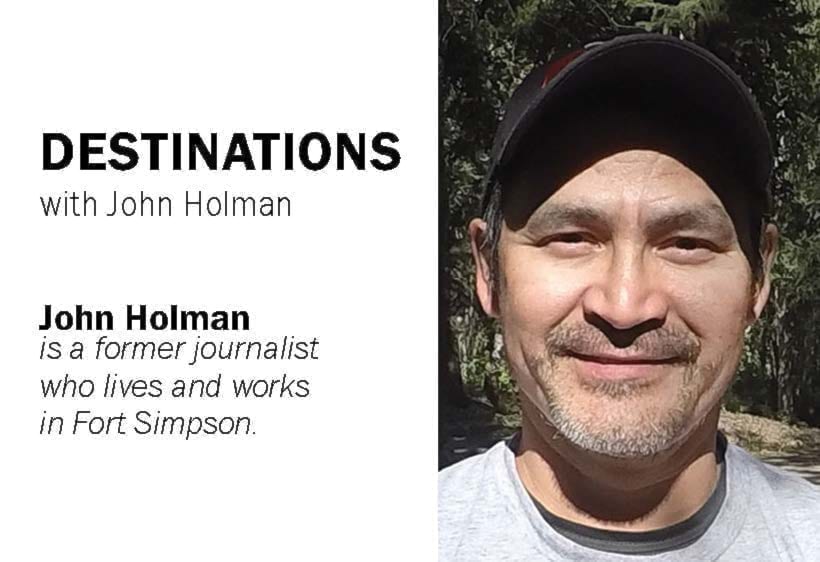by John Holman
On this day, Sept. 10, 1982, we did not have today's temperature of 2 C, but 18.2 C. Ten years before that, in 1972, the mercury dipped to -16.7 C. One thing is for sure, in Fort Simpson we have snow by Halloween, which makes the celebration somewhat wickedly hilarious. Why? The kids have to take off their winter jackets so that those treating them can see their costumes, for the most part.
What is different this year, from the previous three season turns, is that the pressure change that predates the cold and snow was not so sudden, usually occurring over a few days and instantly going from summer one day, to fall the next. Sort of, in fact, this year, we did not have the gentle loss of pressure as the sun recedes its angle and azimuth, with the incremental leaf loss, shrub withering, ice creep on the river shore and blooming and then falling berries. Instead, we had well over a week of North winds blowing down forests all over the Mackenzie Valley, especially around Liidlii Kue, even to de-crowning birch, poplar and willow branches.
Interspersed with rain, this autumn's onset has been marked with gusting winds that ripped conifers out of the ground, even, apparently healthy specimens. The trending floods, hurricanes and weather events that have come to destroy entire states, territories and even cities, are becoming a new global norm. Of course, as a global climate event, this can be used to forecast what may be our future, but we cannot be so hasty.
For one thing, the only proof we really have of the global climate change in the Dehcho is the loss of our ground ice and the channels this is causing to drain our swamp lands, some of which are beginning to resemble prairie. The old geophysical fire lines of the 1940s and 1950s, for example, are still visible from the air, but what is not so visible is that in many places these host standing water, that is, until they drain away. Even around the mainland of Liidlii Kue, for example, there are pockets of deadwood as the snow and permafrost combined to melt out (about a decade ago), killing the flora. All that is left are high grasses, maybe some sedge and that is about it.
These can be considered early characteristics of a climate-related event that was dramatically quick, in our sub-Arctic ecological zone. Nowadays, we have the massive landslides to look forward to on our Dehcho, which was the main cause of the restoration of the Line 21 pipeline. Subsidence, a settling of soils, especially loose soils of those hillsides, will continue to pose an ongoing challenge. Of course, this was an issue brought up with the initial reviews of the (formerly proposed) Mackenzie Valley pipeline, as brought forth by the Aboriginal Pipeline Group.
I specifically had pointed out the permafrost loss and suggested the installation of thermistors for river and creek approaches for the pipeline. That is, artificially-induced ground permafrost to impose stability in the light of its extinction. I did see one of the engineers scribbling away on this suggestion, but what of outcomes? Of course, it is not going to be done until it is too late, which I would say is about now.
Burying the pipeline is reasonable, yes, but; burying it over permafrost is akin to installing it on a frozen lake, so that one day, the structure will have to accommodate the lake once it is thawed. Enter the Canadian hydrology research and their research in thermistors and permafrost thaw and what we have is a solar- and wind-powered installation that keeps the ground frozen. In short, we are looking at inducing a false outcome of weather. The long-term development of our basin, rife with diamonds, petroleum, gold and other minerals, holds promise for us, but with permafrost degradation and the shorter, warmer winters, actually getting to these resource pockets will get more difficult as time progresses.
Our marshes, swampy forests, floating hummocks and water ways are rapidly becoming more homogenous as the global thermometer creeps upwards. The Mackenzie Basin Impact Study, circa 1988, identified this area as a precursor zone of influence, that is, global warming had already been recognized as an existing agent of change on the terrestrial and aquatic environments in the Dehcho. There can only be one outcome, it will either be more difficult to access resources as the water percolates up and saturates the soil's active layer, or easier, as the lands dry out and former wetlands can actually host a road or two.
It is time for a new management regime, perhaps – to contemplate a future with less water in the Dehcho – on lands rich with resources and how to adapt to that? Further, how do we adapt to the changing landscape? Do we have to then build our highways and pipelines on artificial throughways, high above the landscape, literally with ice induction built into the foundation, powered by sunlight and wind power? Considering how our lands are changing, we may have to start adapating, in combination with extreme landscaping.
